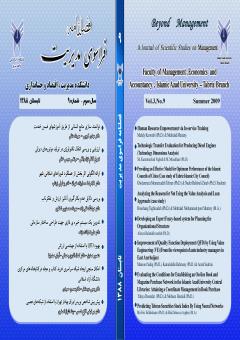Providing an Effective Model for Optimum Performance of the Islamic Councils of Cities (Case study of Tabriz Islamic City Council)
Subject Areas : Business Management
Gholamreza Memarzadeh Tehran
1
*
![]() ,
Nader Bohlouli
2
,
Nader Bohlouli
2
1 - Assistant Professor of Management, Tehran Science and Research Branch, Islamic Azad University, Tehran, Iran
2 - Ph.D. in Public Administration, Science and Research Branch of Tehran, Islamic Azad University, Tehran, Iran
Keywords: effectiveness, Intra-organizational Activities, Inter-organizational Activities, Extra-organizational Activities, Individual Activities, Inter-genous Independence, Exogenous Independous, Freedom of movement,
Abstract :
The present article primarily provides an effective model for optimum performance of the Islamic councils of cities according to fuzzy theory. In this dissertation, the Islamic councils of cities have been supposed as an open organizational system which has four main activities as follows: intra-organizational, inter-organizational, extra-organizational and individual activities. In fact, the proposed model is an optimized proportion of these activities which maximizes the satisfaction of council beneficiaries (clients as direct recipients of services and society as indirect receiver of services).(Of course the 4th activity has been assumed as the research limitation, so it has not been studied). In the proposed Model, at first a fuzzy system has been offered for acquiring the favorable satisfaction of council beneficiaries (outputs) on the basis of the types of activities and their combination (inputs); then different types of city Islamic councils' functions have been considered using different tools for gathering the information of Tabriz Islamic Council according to the available theoretical framework and conforming to diverse activities mentioned before have been estimated in the form of the rate of concentration upon activities and satisfaction of clients of the councils. At the end of the present dissertation, on the basis of the optimized model and the real function of the council, the gap between available and ideal situation has been figured out, and finally, suitable suggestions have been offered for the improvement of the existing conditions.
Anaka, K. (2007). An Introduction to Fuzzy Logic for Practical Applications. A., Vahidian Kamyad & H. R., Tariqian, Mashhad: Ferdowsi University Press, (In Persian).
Bruijn, H. (2002). Performance Measrement in the Public Sector, Strategic to Cope With He Risks of Performance Measrement. International Journal of Public Sector management, 578-594.
Daft, R. (2005). Management. Mason: Thomson South-Western.
Ghobadian , A., & Ashworth, J. (1994). Performance Measurement in Local Government-Concep and Practic. International Journal of operations &production Management, 35-51.
Gibson, B., & Morgan, G. (2004). Sociological Major Theories and Organizational Analysis . Translated by: M. T., Norouzi, Tehran: Samt Publishing, (In Persian).
Gomes, R. C. (2006). Stakeholder Management in the Local Government Decision-Making Area. Available at: http.//www.anpad.org.br/bar.
Guetschow, G. (2006). Culture and co-opreation. Interdependent decision-making in interorganizational networks.
Luthans, F. (1988). Successful vs. Effective Real Managers. LincolnAcademy of Management Executive.
Moghimi, S. M. (2003). The Office of Local Governments Office of Councils and Municipalities. Tehran: Samt Puplication, (In Persian).
Provan, K. G., & Milward, H. B. (1995). A Preliminary Theory ofInterorganizational Network Effectiveness, Administrative Science Quarterly, 40(1)، 1-33.
Riggs, W. F. (1965). The Idea of Development Administration.
Riker, J. V. (1995). Reflections on Government-NGO Relations in Asia، Challenges for People-Centred Development. Asian Pacific Development Centre.
Scott, W. R. (2001). Organizations. Translated by: M. R., Behrangi, Tehran: Nashre Kamale Tarbiat Publishing, (In Persian).
_||_
Anaka, K. (2007). An Introduction to Fuzzy Logic for Practical Applications. A., Vahidian Kamyad & H. R., Tariqian, Mashhad: Ferdowsi University Press, (In Persian).
Bruijn, H. (2002). Performance Measrement in the Public Sector, Strategic to Cope With He Risks of Performance Measrement. International Journal of Public Sector management, 578-594.
Daft, R. (2005). Management. Mason: Thomson South-Western.
Ghobadian , A., & Ashworth, J. (1994). Performance Measurement in Local Government-Concep and Practic. International Journal of operations &production Management, 35-51.
Gibson, B., & Morgan, G. (2004). Sociological Major Theories and Organizational Analysis . Translated by: M. T., Norouzi, Tehran: Samt Publishing, (In Persian).
Gomes, R. C. (2006). Stakeholder Management in the Local Government Decision-Making Area. Available at: http.//www.anpad.org.br/bar.
Guetschow, G. (2006). Culture and co-opreation. Interdependent decision-making in interorganizational networks.
Luthans, F. (1988). Successful vs. Effective Real Managers. LincolnAcademy of Management Executive.
Moghimi, S. M. (2003). The Office of Local Governments Office of Councils and Municipalities. Tehran: Samt Puplication, (In Persian).
Provan, K. G., & Milward, H. B. (1995). A Preliminary Theory ofInterorganizational Network Effectiveness, Administrative Science Quarterly, 40(1)، 1-33.
Riggs, W. F. (1965). The Idea of Development Administration.
Riker, J. V. (1995). Reflections on Government-NGO Relations in Asia، Challenges for People-Centred Development. Asian Pacific Development Centre.
Scott, W. R. (2001). Organizations. Translated by: M. R., Behrangi, Tehran: Nashre Kamale Tarbiat Publishing, (In Persian).

